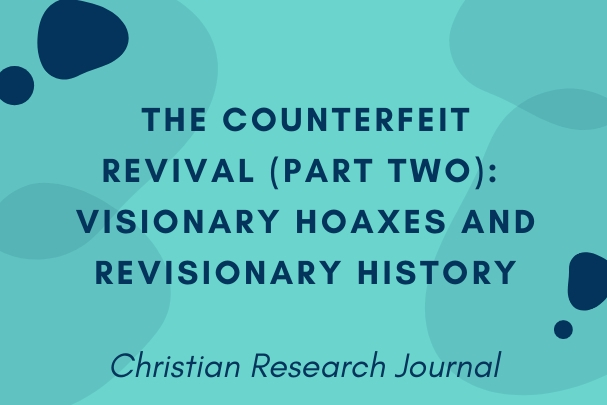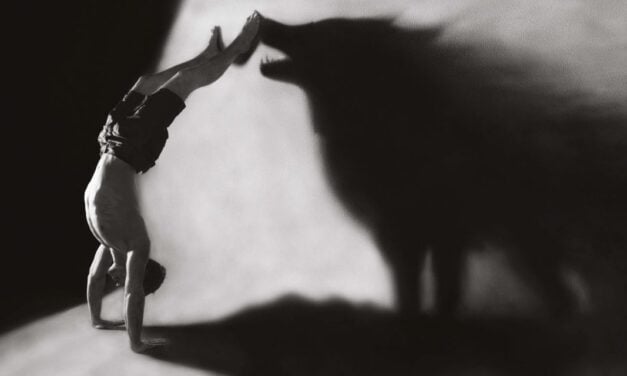This article first appeared in the Christian Research Journal, volume 20, number 1 (September-October 1997). For more information about the Christian Research Journal, click here.
SUMMARY
The deceptions of the Counterfeit Revival include both visionary hoaxes and revisionary history. Its leaders appeal to one of the leading figures in American revivalism, Jonathan Edwards, to prove that the bizarre behaviors and extrabiblical revelations of their own “revival” are signs of an authentic work of God. Edwards did describe unusual manifestations that accompanied conversions during the First Great Awakening, but the great New England theologian was actually one of the most eloquent critics the church has ever seen of the principles and practices that characterize the Counterfeit Revival.
James Ryle, director of the Promise Keepers movement, said that the Voice he heard was the kind that “stops you in your tracks and makes your hair stand on end. It came from above me and had an unmistakable air of authority about it. The Voice simply said, ‘This is the mantle of Zechariah.’”1 After three thundering knocks the Voice spoke once again: “James, it is the Lord!” Suddenly James Ryle understood. The “vast purple mantle” that had fallen upon him in a dream was the mantle of a “seer.”
In his book, A Dream Come True, Ryle says the mantle that fell on him was enormous — “more than any one person could handle.”2 According to Ryle, this blind world will soon be enlightened by an “army of seers.”3 Ryle believes that God not only commissioned him directly, but also called upon Vineyard founder John Wimber to pray that he be “released as a seer.” “From that time forward,” says Ryle, “the frequency, scope, accuracy and fulfillment of dreams, visions and prophetic words has been staggering.”4
Ryle recollects many of these “staggering” revelations in a book titled Hippo in the Garden. Perhaps the most significant of these visions was received on August 22, 1989. The Almighty allegedly gave Ryle a dream about football. In the dream, Ryle saw “something like an energy field” encircling the University of Colorado Buffaloes football team. He then heard a voice that said, “This will be their golden season!”5
The next day Ryle shared the dream as well as its interpretation with Bill McCartney, who was then the Colorado coach and who later founded the national Christian men’s group Promise Keepers. Ryle said, “The Lord will now fulfill promises which He has made to you by empowering the players with His Spirit. This will be the golden season!”6 At the end of the golden season, before the championship game, Ryle says, “I felt certain that we would win and be crowned the national champions of college football — we were already firmly locked in the number one position in the polls. I was sure that we would win; my confidence was unshakable!” (emphasis in original).7
Minutes before the national championship game, however, the Lord gave Ryle a tragic revelation through a female buffalo named Ralphie. Via the omen8 of Ralphie’s broken horn, God revealed that the power of His Spirit had departed from the team.9 This time, however, Ryle kept the revelation to himself until after the game.
As he stood stunned in the stadium, contemplating Colorado’s crushing 21 to 6 loss to Notre Dame, the Holy Spirit told Ryle to turn to Isaiah 21:6.10 While the content of Isaiah 21:6 has no correspondence to football games, Ryle says “my curiosity was awakened.”11
After the disappointing ending to the Buffaloes’ golden season God revealed to Ryle that he would “reach out His hand a second time” (Isa. 11:11).12 And, sure enough, the following year, the Colorado Buffaloes were again pitted against Notre Dame in the national championship game. Prior to the game, Ryle once again checked for a sign, using Ralphie’s horns as an omen. This time they were intact, thus Colorado went on to win the national championship of college football. Astonishingly, the omen was confirmed for Ryle by the season win-loss-tie record (11-1-1) that matched the passage (Isaiah 11:11) that the Holy Spirit had prompted him to consult.13
A JACK WITH A LANTERN
While at first blush Ryle’s revelations appear to be solid gold, a closer look exposes them for what they really are — fool’s gold. Ryle claims that God communicated inside information to him via the omen of a buffalo horn, but Scripture clearly denounces any such interpretation of omens (Deut. 18:10).
It is safe to say that when James Ryle alleges that he received “direction from heaven” to read Isaiah 21:6 (after the Colorado Buffaloes lost to Notre Dame 21 to 6), he is merely communicating the delusions of his own mind. We can also be assured that Ryle is presumptuous in alleging that the Holy Spirit revealed to him a year in advance that Colorado would win the national championship of college football by directing him to read an esoteric meaning into Isaiah 11:11.
More than two hundred years ago Jonathan Edwards (1703-1758) addressed this sort of “Bible Roulette” when he said,
Some that follow impulses and impressions indulge a notion, that they do no other than follow the guidance of God’s word, because the impression is made with a text of Scripture that comes to their mind. But they take that text as it is impressed on their minds, and improve it as a new revelation to all intents and purposes; while the text, as it is in the Bible, implies no such thing, and they themselves do not suppose that any such revelation was contained in it before….
If such things as these are revealed by the impression of these words, it is to all intents a new revelation, not the less because certain words of Scripture are made use of in the case. Here are propositions or truths entirely new, that those words do not contain…wholly different from those contained in the text of Scripture….
This is quite a different thing from the Spirit’s enlightening the mind to understand the words of God, and know what is contained and revealed in them…and to see how they are applicable to our case and circumstances; which is done without any new revelation, only by enabling the mind to understand and apply a revelation already made.14
Rather than indulging impulses and impressions, Edwards advises Christians to “take the Scriptures as our guide.” Without the final standard of Scripture the body of Christ lies open to “woeful delusions and would be exposed without remedy to be imposed on and devoured by its enemies.”15 Edwards implores Christians “to be contented with the divine oracles — that holy pure word of God, which we have in such abundance and clearness”:
Why should we desire to have any thing added to them by impulses….Why should we not rest in that standing rule that God has given to his church, which the apostles teach us (2 Peter 1:12-21) is surer than a voice from heaven?
They who leave the sure word of prophecy — which God has given us a light shining in a dark place — to follow such impressions and impulses, leave the guidance of the polar star to follow a Jack with a lantern.16
Ryle is not alone in leaving “the guidance of the polar star” to follow “a Jack with a lantern.” A host of others have followed in his footsteps.
A GREAT APOSTASY
Ryle’s deceptions are not limited to visionary hoaxes. They extend to revisionary history as well. As Ryle has exchanged God’s enduring revelation for his own erroneous revelations, so, too, he has exchanged historical realities for historical revisionism.
In this, too, Ryle is not alone. In teachings, transcripts, tapes, and television appearances, men like John Arnott (Toronto Airport Vineyard), Guy Chevreau (Catch the Fire), Gerald Coates (Holy Trinity, Brompton), Patrick Dixon (Signs of Revival), and a host of other Counterfeit Revival proponents are actively deceiving devotees by revising history. Their primary ploy is to persuade people that sardonic laughter, spasmodic jerks, slaying in the spirit, and other “enthusiasms” were not only pervasive in the First Great Awakening (the widespread revival of personal faith in Christ that took place in 18th century colonial America) but were promoted by such historical heavyweights as Jonathan Edwards (popularly cited as one of the greatest theological minds produced in America).
One of the most brazen examples of historical revisionism comes from the lips of John Arnott. At an international pastors’ conference, Arnott tried to dupe devotees by denouncing the theology of John Calvin while in the same breath affirming the theology of Jonathan Edwards. Arnott was attempting to refute “cessationists,” whom he believes were “shutting down the Holy Spirit” by questioning the practice of “acting like lions and oxen and eagles and even warriors.” His basic argument was that since “God Himself has no hesitation of comparing Himself to an animal,” we shouldn’t either. Thus, according to Arnott, Calvinists and cessationists would be “far better advised to refer to Jonathan Edwards and his theology on discernment….”17
While Arnott no doubt knew that Edwards was a Calvinist and a cessationist (believing that such supernatural gifts as tongues and prophecy had ceased), he apparently banked on the fact that his followers did not. Arnott, however, is not alone in this deception. Counterfeit Revival “historian” William DeArteaga, for example, uses the Toronto Airport Vineyard as his bully pulpit to simultaneously condemn Calvinism and commend the theology of Jonathan Edwards. DeArteaga compounds the deception by telling devotees that Edwards’s contemporary critic, Charles Chauncey, “ensured the defeat of the Awakening” by “using the assumption of Calvinist theology.”18
In truth, far from using Calvinism to ensure the defeat of the Great Awakening, Charles Chauncey was an Arminian who opposed “the resurgence of Calvinistic theology — especially as preached by Jonathan Edwards.”19
The most disturbing deception of all is that the leaders of the Counterfeit Revival have co-opted one of the church’s true spiritual giants and dishonestly claimed him for their own. In the words of William DeArteaga, “The Lord has already chosen the predominant theologian of this revival. It’s not me! It’s Jonathan Edwards” (emphasis added).20
Nothing, however, could be further from the truth. The theological focus of Jonathan Edwards was on eternal verities such as sin, salvation, and sanctification. In sharp contrast, the temporal fixation of men like John Arnott is on such earthly vanities as sardonic laughter, spasmodic jerks, and being slain in the spirit. While Jonathan Edwards personified a passion for piety, John Arnott personifies a priority for parties. Dr. Nick Needham has well said that anyone who believes that Jonathan Edwards would have approved of this paradigm shift “must surely have kissed a final farewell to his mind.”21
JONATHAN EDWARDS
Leaders of the Counterfeit Revival have appealed to Jonathan Edwards. Thus, to Jonathan Edwards we shall now go. Nowhere is there a more compelling contrast between counterfeit and genuine revival than in Edwards’s manuscript titled The Distinguishing Marks of a Work of the Spirit of God.22
He identifies nine characteristics that critics seized on to negate the Great Awakening as a genuine work of the Spirit. Edwards draws a clear line of demarcation between Great Awakening and great apostasy. The signs identified by Edwards are so significant that I have alliterated them to make them easy to review and remember.23
Extraordinary Enthusiasms
What the church has been used to, is not a rule by which we are to judge;because there may be new and extraordinary works of God.24
In his book, Catch The Fire, Counterfeit Revival historian Guy Chevreau goes to great lengths to “prove” that the “new and extraordinary works of God” to which Edwards referred are precisely what Chevreau experienced when he first visited the Toronto Airport Vineyard. He confesses that he was “too desperate to be critical”25 when he first encountered the “uncontrollable laughter and inconsolable weeping; violent shaking and falling down; people waving their arms around, in windmill-like motions, or vigorous judo-like chopping with their forearms.”26 Thus, when John Arnott prayed that Chevreau’s wife, Janis, would remain in a drunken stupor for 48 hours, Chevreau did not attempt to intervene. Instead, he proudly proclaimed that Arnott’s prayer had been abundantly answered. For more than two days Janis fell “repeatedly,” was “hysterical with laughter,” and was “unable to walk a straight line.”27 So severe was her spiritual drunkenness that Janis was completely unfit to drive.
On worldwide television Janis witnessed to the “new and extraordinary works of God” by telling Phil Donahue that for four hours she had rolled around under chairs at church. She went on to testify that the very next day she began to “toss hot greasy fish” at parishioners during a very serious dinner meeting. Guy Chevreau (now a teacher at the Toronto Airport Vineyard) spends almost a third of his book attempting to convince readers that these were precisely the kinds of new and “extraordinary enthusiasms” that Edwards defined and defended.
In doing so Chevreau corrupts the clear intention of Edwards’s words. When Edwards spoke of the “new and extraordinary work of God,” he was referring to the Spirit’s “ordinary work of converting sinners, but carried on at certain points in history in an extraordinary way as far as numbers and community-wide consequences were concerned.”28
Chevreau also blurs the distinction between the experiences of his wife and those of the wife of Jonathan Edwards. In clear contrast to the “very flaky”29 beliefs and behavior of Janis Chevreau, Edwards affirms that his wife, Sarah, experienced the glory and grandeur of God.30 Dr. Nick Needham points out that what Jonathan and Sarah Edwards approved of was “the complete mirror-image of such fun-drunk spiritual ‘parties.’ Perhaps Edwards was wrong. Perhaps he was spiritually deficient in his sense of humor. But it is profoundly dishonest to appeal to Edwards’s name to give credibility to a spiritual ethos he would have abhorred with ever fiber of his lofty and reverent soul….”31
While Chevreau couches Edwards’s comments in the context of Counterfeit Revival chaos, in truth his commentary is clearly communicated within the context of Great Awakening conversions. Perhaps this distinction is best personified by the experience of a non-Christian reporter named Mick Brown, who traveled to Toronto on assignment for a secular magazine.
For the most part Brown was singularly unimpressed by what he experienced. He described the sermons as “turgid enough to tax the most devout believer.”32 At one point he even left the spiritually intoxicated gathering for a quick beer in a nearby bar. His account, however, concludes with a startling revelation:
Perhaps it was the heat, or the air of febrile intoxication coursing through the air, but I could feel myself growing giddy.
….I didn’t even see [Pastor John Arnott’s] hand coming as it arced through the air and touched me gently — hardly at all — on the forehead. “And bless this one, Lord….” I could feel a palpable shock running through me, then I was falling backwards, as if my legs had been kicked away from underneath me.
I hit the floor — I swear this is the truth — laughing like a train.33
In a subsequent interview, Brown said, “I’m not and I wasn’t a practicing Christian before going to Toronto, but I’ve always had an interest in all sorts of different religious experience.”34 He went on to say that in his estimation “every culture and every faith expresses an understanding of God, or the divine, in their own particular way, and the divine does not discriminate between different cultures, [or] between different religions.”35
Brown’s account of his Toronto Vineyard experience bears an eerie resemblance to a previous encounter he had with a Hindu avatar named Mother Meera: “I went to see her, took darshan with her. Darshan means (literally) an audience with a teacher, and it was a very powerful experience. What it actually involved was her taking my head in her hands for about a minute or so, and then lifting my head up and holding my gaze for another minute or so. The immediate effect was an extreme warmth on my face, a burning sensation, which lasted for a few hours afterwards….The feeling of euphoria lasted for two or three days.”36
Brown says he did not experience long-term change as the result of either his encounter with Mother Meera or with John Arnott. He didn’t change his reservations about Christianity, nor did it make him think “that Buddhism, Hinduism, Islam, Red Indian Shamanism or whatever other kind of manifestation of faith could go out with the bath water.” After leaving the Toronto Airport Vineyard Brown was more convinced than ever that Christ was merely “a sort of man, someone through whom God was working.”37
Tragically, after a prolonged visit to the Toronto Airport Vineyard, Brown had experienced sardonic laughter but had not encountered a single sermon on salvation. Instead of being saved by the Spirit of the Lord he had merely been slain by the spirit of laughter. As Dr. Needham rightly observed, “There is something slightly sinister about Christians having a self-indulgent spiritual ‘party’ while the world around them is sliding into the outer darkness, where there is weeping and gnashing of teeth, where the worm never dies and the fire is never quenched. Edwards teaches us that we need to confront the soul-destroying idolatry of entertainment and fun that dominates our society, and appears to be hypnotizing and seducing the Church.”38
Effects on the Body
The misery of hell is doubtless so dreadful, and eternity so vast, that if a person should have a clear apprehension of that misery as it is, it would be more than his feeble frame could bear.39
“One night I was preaching on hell,” boasts Counterfeit Revival leader Rodney Howard-Browne, when suddenly laughter “just hit the whole place. The more I told people what hell was like, the more they laughed.”40 This was not an isolated incident. An associate confirmed Howard-Browne’s account by announcing that as he told his parishioners the story of God’s judgment on Ananias and Sapphira, “everyone ended up on the floor laughing.”41
Jonathan Edwards provides a completely different perspective. When leaders of the Great Awakening preached on the terrors of hell and impending judgment, people were moved by the Spirit and experienced weakness and weeping. The reality of hell and the brevity of life so engaged their minds that they experienced corresponding effects in their bodies. Rather than being deliberately produced by the laying on of hands or loud shouts of “More, Lord!” these bodily effects were the spontaneous results of a vivid encounter with eternal verities. As Edwards elaborated,
If we should suppose that a person saw himself hanging over a great pit, full of fierce and glowing flames, by a thread that he knew to be very weak, and not sufficient to bear his weight, and knew that multitudes had been in such circumstances before, and that most of them had fallen and perished, and saw nothing within reach, that he could take hold of and save him, what distress would he be in! How ready to think that now the thread was breaking, that now, this minute, he should be swallowed up in those dreadful flames! And would not he be ready to cry out in such circumstances? How much more those that see themselves in this manner hanging over an infinitely more dreadful pit, or held over it in the hand of God, who at the same time they see to be exceedingly provoked! No wonder that the wrath of God when manifested but a little to the soul, overbears human strength (emphases in original).42
Edwards made it crystal clear that a true valuation of the judgment of God and the terror of hell produces such powerful inner emotions that corresponding effects on the body are only natural.
Likewise, those who get even a glimpse of the glory and grandeur of God may well also experience effects in their bodies. Edwards explained, “A true sense of the glorious excellency of the Lord Jesus Christ, and of his wonderful dying love, and the exercise of a truly spiritual love and joy, should be such as very much to overcome the bodily strength.”43
The effects on the body described by men like Jonathan Edwards were never random or ridiculous but were the result of real spiritual awakening. The effects on the body produced through men like Rodney Howard-Browne are largely the result of sociopsychological manipulation (see Part Four of this series).
Leaders of the Counterfeit Revival proudly promote bodily effects such as sardonic laughter, spasmodic jerks, and “surfing in the spirit” and perceive preaching as virtually pointless. As Rodney Howard-Browne acknowledges, “As to what you’re preaching on, it’s almost irrelevant.”44 In sharp contrast, leaders of the Great Awakening believed that powerful preaching on sin, salvation, and sanctification was paramount. Again, Dr. Nick Needham poignantly proclaims it: “The idea that true spiritual joy can be expressed by laughter, or by any kind of lightness (what we might call fun or clowning), has never had a more determined opponent than Jonathan Edwards. Those Toronto apologists who appeal to him to justify such modern-day phenomena are either speaking out of a profound ignorance, because they have not troubled to read Edwards at all, or are irresponsibly and deceptively misrepresenting Edwards’s clear and forceful teaching on the subject.”45
Endorsements
When Christ’s kingdom came, by that remarkable pouring out of the Spirit in the apostles’ days, it occasioned a great stir every where.46
“The fire is blazing out of control,”47 boasted John Arnott. The “world-wide spread” is so dramatic that “opposition to this move of God is becoming very much like a fly on an elephant.”48 Despite the fact that “tens of thousands of pastors”49 and hundreds of thousands of participants have been impacted, Arnott contends we haven’t seen anything yet: “We are currently in a time similar to the ministry of John the Baptist and will soon be coming into a time resembling the ministry of Jesus where powerful signs, wonders and miracles will take place.”50
Arnott’s words are a common refrain among leaders of the Counterfeit Revival. Rick Joyner goes so far as to prophesy that the “faithful will soon walk in unprecedented power and authority. In the near future we will not be looking back at the early church with envy because of the great exploits of those days, but all will be saying that He certainly did save His best wine for last. The most glorious times in all of history have now come upon us. You who have dreamed of one day being able to talk with Peter, John and Paul, are going to be surprised to find that they have all been waiting to talk to you!”51
Leaders of the Counterfeit Revival cite the widespread acceptance of their movement as proof that it is a work of the Spirit. Leaders of the Great Awakening did not. While Jonathan Edwards acknowledged that the outpouring of the Spirit in the days of the apostles caused a great stir, he resisted the notion that the expansion of a movement was an endorsement from God. If size, scope, and spread were validations for a religious movement, one would be compelled to accept the counterfeit Christ of the New Age movement.
Edwards knew full well that the record of history bore eloquent testimony to the fact that a great apostasy can spread as rapidly as a great awakening. In the days of Athanasius (295-373) the Arian apostasy52 spread so swiftly that it threatened to pervert the Christian church into a cultic confederation. The endorsement of Arianism by the emperor escalated the spread of this egregious error throughout the empire. Athanasius, however, stood against the tide. While the world stood against Athanasius, Athanasius stood against the world.
Esoteric Imaginations
It is no wonder that many persons do not well distinguish between that which is imaginary and that which is intellectual and spiritual; and that they are apt to lay too much weight on the imaginary part, and are most ready to speak of that in the account they give of their experiences, especially persons of less understanding and of distinguishing capacity.53
In his book, A Dream Come True, James Ryle characterizes a dream or a vision as “a puzzle waiting to be solved, a promise waiting to be realized, or a premonition waiting to happen.”54 To validate his “peculiar fascination,” Ryle turns to a priest and Jungian analyst named Morton Kelsey (a devotee of occult practices) who describes Jesus Christ and his disciples as shamans (sorcerers).
Ryle quotes Kelsey as saying that after a 10-year study on dreams and visions, “I discovered that my dreams were wiser than my well-tuned rational mind….These strange messengers of the night offered suggestions on how to find my way out of my lostness.”55 Ryle dismisses those who disagree with this as “arrogant and ignorant.”56
Rather than dismissing dissenters, Ryle should have warned devotees of the dangers inherent in Kelsey’s world view. Kelsey believes that “almost all Christians who were true disciples were something like shamans in the style of their master.”57 As he put it, “Jesus not only used these powers [of the shaman] Himself but He passed the same powers of superhuman knowledge, healing and exorcism on to his followers.”58
Kelsey not only recasts Christ in the image of a shaman but he turns Christians on to such committed occultists as Carlos Castaneda (dubbed by the Los Angeles Times as one of the “godfathers of the New Age movement”59). This despite the fact that Castaneda classifies the art of dreaming as the most vital method of the sorcerer’s armory and also the most dangerous. After indulging in this practice for many years, Castaneda recalls, “In my daily state I was nearly an idiot, and in the second attention [altered state of consciousness] I was a lunatic.” 60
Ironically, while Bill McCartney enthusiastically endorses the practices and principles of James Ryle, Castaneda warns devotees of the dangers inherent in the world of visions and dreams. From his vantage point as a New Age guru, Castaneda writes, “Everything in the sorcerer’s path is a matter of life or death, but in the path of dreaming, this matter is enhanced a hundred fold…that’s why you have to go into their realm exactly as if you were venturing into a war zone.” 61 As personified by the life of James Ryle, once one is immersed in the world of dreams and visions, it becomes increasingly difficult to distinguish fact from fantasy.
In clear contrast, Jonathan Edwards was convinced that esoteric imaginations are at best human hallucinations and at worst demonic deceptions. He stood fast against those who attempted to elevate their esoteric experiences to the status of divine revelation. As Edwards explained, “Some are ready to interpret such things wrong, and to lay too much weight on them, as prophetical visions, divine revelations, and sometimes significations from heaven of what shall come to pass.”62
Edwards further explains that imaginary ideas are the natural byproduct of a powerful religious experience. As he put it, “Such is our nature, that we cannot think of things invisible, without a degree of imagination. I dare appeal to any man, of the greatest powers of mind, whether he is able to fix his thoughts on God, or Christ, or the things of another world, without imaginary ideas attending his meditations.”63 Edwards goes on to warn his hearers of supposing that their imaginations are “of the same nature with the visions of the prophets, or St. Paul’s rapture into paradise.”64
Unlike the oracles of James Ryle, the oratory of Jonathan Edwards always focused followers on such biblical realities as the felicities of heaven and the fires of hell. This is precisely what happened when Edwards preached the sermon for which he is most noted, “Sinners in the Hands of an Angry God.” His oratory aroused in his audience visions of what it would be like to experience an eternity away from the grace and goodness of God. Thus, far from their visions being esoteric imaginations they were instead eternal illuminations.
Examples
Not only weak and ignorant people are much influenced by example,but also those that make the greatest boast of strength of reason.65
Carol Arnott claims the Almighty spoke to her husband saying, “I want you to hang around people that have an anointing.” According to Carol, God directed them to a man named Benny Hinn, with whom John had “ministered” in the early years. Carol heeded the Word of the Lord and began “to hang around” with Hinn. As a result, she says, “I just got absolutely buzzing with the anointing of God.”66 According to the Arnotts, Hinn prayed for them some “fifty times.” And the effects of his example are today being experienced around the globe.
Jonathan Edwards was fully aware of the contagious power of example. Thus, he reminds us of Paul’s instruction to young Timothy: “Don’t let anyone look down on you because you are young, but set an example for the believers in speech, in life, in love, in faith and in purity. Until I come, devote yourself to the public reading of Scripture, to preaching and to teaching” (1 Tim. 4: 12-13; emphasis added). Edwards insisted that Scripture was the principle means through which the power of example is made effectual: “Even the sacraments have no effect but by the Word. And so it is that example becomes effectual. For all that is visible to the eye is unintelligible and vain without the Word of God to instruct and guide the mind.”67
One can only imagine what Edwards might have said had he encountered the example of Benny Hinn slaying supporters in the spirit by casting his coat at a crowd or blowing on believers. It boggles the mind to think of how he would have reacted had he witnessed Stephanie Wimber leading by example as she jerked spasmodically in what her father fondly referred to as the “chicken walk.” While Edwards clearly maintained that it was “agreeable to Scripture that persons should be influenced by one another’s good example” he would have surely resisted such ghastly examples with every “fiber of his lofty and reverent soul.”
Excessive Zeal
Lukewarmness in religion is abominable and zeal an excellent grace; yet above all other Christian virtues, this needs to be strictly watched and searched; for it is that with which corruption, and particularly pride and human passion is exceedingly apt to mix unobserved.68
Counterfeit Revival leader Larry Randolph, speaking at the Toronto Airport Vineyard, declared that there are only “two groups of people in the church today.” He categorized them as “those that are affected by what God’s doing and those that are offended by what God is doing. There is not a lot of neutral ground. The neutral ground is dissipating by the hour. You can’t stand in the middle any more and say ‘Well, I don’t know. Maybe it’s God, maybe it’s not.’ You’re going to get rolled over.”69
Counterfeit Revival leaders Bob Jones and James Ryle agree. They predict that the party God is presently throwing for His people will soon give way to a bloody civil war. On one side of the war will be “blues” who readily accept new revelations from God. On the other will be “grays” who rely solely on the revelation God has already given. According to Rick Joyner, the grays (whom he labels as “spiritually ruthless and cruel”70) will “either be converted or removed from their place of influence in the church.”71
Joyner dogmatically declares that both “believers and unbelievers alike will think that it is the end of Christianity as we know it, and it will be.”72 When the “grays” are finally eliminated there is going to be “an entirely new definition of Christianity.”73
While leaders of the Counterfeit Revival predict a great battle in which those who stand against them will be eliminated, Jonathan Edwards warned against just such a “holy war.” He made it clear that even in a cause as crucial as the Reformation, kindness rather than killing should be the order of the day. As he sadly reflected, even “in that glorious revival of religion, at the reformation, zeal in many instances appeared in a very improper severity, and even a degree of persecution.”74 In place of excessive zealousness that predicts a bloodbath in which those who refuse to accept new revelations are eliminated, the life of Jonathan Edwards personified the maxim, “In essentials unity; in nonessentials liberty; and in all things charity.”
End-Time Revelations
However great a spiritual influence may be, it is not to be expected that the Spirit of God should be given now in the same manner as to the apostles, infallibly to guide them in points of Christian doctrine, so that what they taught might be relied on as a rule to the Christian church.75
In a vision concerning the end-time harvest, Jesus allegedly revealed to Rick Joyner that there would be “a great reaping among the Jehovah’s Witnesses, Mormons, Seventh Day Adventists, and other sects in which there is a doctrinal mixture.” Jesus went on to point out that these sects would “be won by love, not truth.”76 According to Joyner, Jesus is about to “enormously increase” our understanding on even such basic truths as “salvation and being born again.”77 He even predicts that the end-time church will rise above differences in doctrine and “worship Him in unity.”78 Ominously, he warns that anyone who resists this new “tide of unity” based on love rather than doctrine will be disqualified or removed from leadership: “Some who are presently in leadership that resist this move will become so hardened they will become opposers and persecutors of the church. Others will be changed and repent of their hardness of heart, even though, in some cases, their resistance to the Holy Spirit will have disqualified them from leadership. This growing tide of unity in the church will reveal the true nature of those in leadership.”79
Counterfeit Revival historian William DeArteaga goes even further. He denounces those who make essential Christian doctrine a prerequisite for unity. According to DeArteaga, such people are guilty of “Pharisaism,” which he defines as “the heresy of orthodoxy.”80 He explains that the “core problem with the Pharisee is that he cannot recognize the present work of the Holy Spirit.”81
One could imagine Jonathan Edwards not only turning over in his grave at such bizarre notions but going into high rotation. Pharisaism cannot be correctly defined as orthodoxy, nor should orthodoxy be denounced as heresy. Edwards would have blanched at the mere mention of unity at the expense of essential Christian doctrine.
While Rick Joyner seemingly sees no need for the absolute, external, objective standard of Scripture by which to test his end-time visions, Jonathan Edwards was firmly committed to the principle of sola scriptura. He warned that even some godly men during the Great Awakening had been deluded by imagining that their impulses and impressions were infallible revelations: “Many godly persons have undoubtedly in this and other ages, exposed themselves to woeful delusions, by an aptness to lay too much weight on impulses and impressions, as if they were immediate revelations from God, to signify something future, or to direct them where to go, and what to do.”82
Erroneous Judgments
And it is particularly observable, that in times of great pouring out of the Spirit to revive religion in the world, a number of those who for a while seemed to partake in it,have fallen off into whimsical and extravagant errors, and gross enthusiasm, boasting of high degrees of spirituality and perfection, censuring and condemning others as carnal.83
James Ryle likens those who speak out against the “extravagant errors” of the Counterfeit Revival to those “who crucified Jesus Christ.” He not only condemns critics as carnal, but characterizes them as the corrupt Pharisees of Christ’s day. Not content to cast judgment upon their eternal destiny, he judges their present motivations as well: “What motivates them to tear down another church? The answer is pride, jealousy, fear, hatred or ignorance. Take your pick. You can be sure one of these factors is at the heart of this present contention.”84
Likewise, TBN president Paul Crouch does not hesitate in “censuring and condemning” those who criticize the false teachings that are regularly featured on the Trinity Broadcasting Network. His judgment is swift and severe: “I think they’re damned and on their way to hell; and I don’t think there’s any redemption for them.” He ominously warns critics to “get out of God’s way. Quit blocking God’s bridges, or God’s gonna shoot you if I don’t.”85 Like Crouch, Toronto Airport Vineyard pastor Marc Dupont warns critics of the Counterfeit Revival that their fate may well be as severe as death:
There is a judgment that’s coming against many leaders and against the church that despises what God is doing in the nineties….I believe judgment this year is radically increasing, especially leaders that are going to stand in a strong Pharisaical stance and are going to attack what God is doing….I believe that many leaders who are fighting what the Spirit of God is doing and saying, God is going to take them out of ministry. I believe some of them, I know this isn’t a new revelation, other people have said this, but I do believe that it’s true, that God is actually going to be taking some leaders home to heaven, rather than to continue to allow them to mislead God’s people.86
Jonathan Edwards cautioned against just such judgments. He pointed out that even though Judas was a devil “he had been treated by Jesus himself, in all external things, as if he had truly been a disciple.”87 While we may rightly judge a person’s doctrines and deeds in light of Scripture (Acts 17:11; 1 Thess. 5:21-22; Gal. 1:6-10; 2 Cor. 11:4ff), we must never pass judgment on their motives or eternal destiny. That is the sole prerogative of God, who alone can search our hearts and who alone has the power to sentence one to hell. As Edwards said of Judas:
Though Christ knew him, yet he did not then clothe himself with the character of omniscient Judge, and searcher of hearts, but acted the part of a minister of the visible church; (for he was his Father’s minister); and therefore rejected him not, till he had discovered himself by his scandalous practice; thereby giving an example to guides and rulers of the visible church, not to take it upon them to act the part of searcher of hearts, but to be influenced in their administrations by what is visible and open.88
Eudaemonism
The main work of ministers is to preach the gospel. 89
During the first anniversary celebration of the “Toronto Blessing,” a pastor stood up and asked Randy Clark why the present revival, unlike historical revivals, had not placed a strong emphasis on the holiness of God and the depravity of man. Clark responded by saying that in the current revival God decided to throw a party for his people because they “already feel so icky about themselves.”90 Like other leaders of the Counterfeit Revival, Clark seems convinced that God’s present priority is entertainment rather than evangelism. In sharp contrast to Jonathan Edwards, he seems to believe that God’s priority is to make us happy as opposed to making us holy.
J. I. Packer sums up such notions with the word eudaemonism, which is the “basic principle of hot tub religion.”91 Webster defines eudaemonism as the doctrine of happiness, or the system of ethics that considers the moral value of actions in terms of their ability to produce happiness. In stark contrast to Randy Clark, Packer bemoans the fact that this is “a false principle. It loses sight of the place of pain in sanctification whereby God trains his children to share his holiness (see Hebrews 12: 5-11).”92
Leaders of the Counterfeit Revival believe “this recent move of the Spirit is the Lord romancing His church” (emphasis added).93 Leaders of the Great Awakening believed that the move of the Spirit was the Lord reforming His church. As in our day, 18th century Christianity had assumed the barnacles of the Enlightenment and had come to believe that the pursuit of happiness is the loftiest human goal. In his book titled The Scandal of the Evangelical Mind, Mark Noll points out that “the intellectual achievement of Jonathan Edwards was his refusal to admit that these assumptions were in fact the starting points of thought.” Edwards “resisted the idea that the pursuit of happiness was the highest purpose of human life.”94 Unlike Randy Clark, he was convinced that the reason the church needed reformation was not because Christians “feel so icky about themselves” but rather because they don’t feel icky enough. Rhetorically, he asks, “Is it really grievous to you, that you have fallen, or do fall into sin; and are you ready, after the example of holy Job, to abhor yourself for it, and repent in dust and ashes, and like Paul to lament your wretchedness, and pray to be delivered from sin, as you would from a body of death?”95 If you do, then, according to Edwards, “you have the evidence that your grace is of the kind that tends to holy practice, and to growth.”96
It is the height of irony that Counterfeit Revival leaders compare themselves to Great Awakening revivalists, who were criticized, not for serving intoxicating Holy Ghost laughter, but for “insisting very much on the terrors of God’s holy law, and that with a great deal of pathos and earnestness.”97 Far from discrediting the Great Awakening as a work of God, Edwards made it clear that warnings about the reality of hell were an indispensable part of proclaiming the gospel. Without knowing how desperately “icky” we really are, we will never fully grasp the greatness of our salvation. As Edwards passionately proclaimed:
If there be really a hell of such dreadful and never-ending torments, as is generally supposed, of which multitudes are in great danger…then why is it not proper for those who have the care of souls to take great pains to make men sensible of it?….If I am in danger of going to hell, I should be glad to know as much as possibly I can of the dreadfulness of it. If I am very prone to neglect due care to avoid it, he does me the best kindness, who does most to represent to me the truth of the case, that sets forth my misery and danger in the liveliest manner.98
The Paradigm Shift
Nowhere is the paradigm shift that has taken place in Christianity and our culture more obvious than in the contrast between the ministry of Jonathan Edwards and the message of the leaders of today’s Counterfeit Revival. The ministry of Jonathan Edwards was characterized by dynamic expositional preaching. The message of the Counterfeit Revival is characterized by delusional experiential pandering.
While the Great Awakening was an era of exoteric exposition, the Counterfeit Revival is an era of esoteric experience. Today thousands are being deceived into believing that reality can be transformed into a personal experience of enlightenment — a transformation of consciousness that initiates them into true spirituality. The very thing that Edwards wanted people to be saved from is what Counterfeit Revival leaders are inducing people to indulge in.
*This article is adapted from Hank Hanegraaff’s book, Counterfeit Revival, published by Word Publishing, April 1997. To order, call toll-free at (888) 7000-CRI.
NOTES
- James Ryle, A Dream Come True (Orlando: Creation House, 1995), 218.
- Ibid., 218-19, 224-25.
- Ibid., 229.
- James Ryle, Hippo in the Garden (Orlando: Creation House, 1993), 13.
- Ibid., 181.
- Ibid.
- bid., 182.
- The word “omen” is defined as “an occurrence or phenomenon believed to portend a future event.” (Merriam Webster’s Collegiate Dictionary, 10th ed. [Springfield, MA: Merriam-Webster, 1994].)
- Ryle, Hippo, 182-83.
- Ryle didn’t worry about taking the verse in its historical context because he believes that while “the verse may, in fact, be taken completely out of its historical context, it nevertheless has direct bearing on some immediate situation we’re facing.” (Ibid., 77.)
- Ibid., 182.
- Ibid., 183.
- Ibid.
- Jonathan Edwards, The Works of Jonathan Edwards, vol. 1, ed. Edward Hickman (Carlisle, PA: Banner of Truth Trust, 1974: reprint of 1834 edition), 404.
- Jonathan Edwards, The Works of Jonathan Edwards, vol. 2, ed. Edward Hickman (Carlisle, PA: Banner of Truth Trust, 1974: reprint of 1834 edition), 260.
- The Works of Jonathan Edwards, vol. 1, 404 and vol. 2, 275.
- John Arnott, “Pastor’s Meeting,” Toronto Airport Vineyard, 19 October 1994; audiotape transcript.
- William DeArteaga, Quenching the Spirit (Altamonte Springs, FL: Creation House Publishers, 1992), 52.
- J. D. Douglas, Philip W. Comfort, and Donald Mitchell, eds, Who’s Who in Christian History (Wheaton, IL: Tyndale House Publishers, 1992), 156.
- William DeArteaga, “What Is Heresy?” Toronto Airport Vineyard, 13 October 1994; audiotape transcript.
- Nick Needham, Was Jonathan Edwards the Founding Father of the Toronto Blessing? Part One – Phenomena Which Do Not Prove That the Spirit Is Present (Welling, Kent, England: Nick Needham [self-published], 1995), 20.
- Jonathan Edwards, “The Distinguishing Marks of a Work of the Spirit of God,” in The Works of Jonathan Edwards, vol. 2, 257-77.
- My thanks to Dr. Nick Needham for sharing with me his comparison of the Edwards essay with the Counterfeit Revival. Although our analyses are substantially different, they are complementary and it is to him that I owe the inspiration for making my own comparison.
- The Works of Jonathan Edwards, vol. 2, 261.
- Guy Chevreau, Catch the Fire (London: Marshall Pickering [HarperCollins] 1994), 12-13.
- Ibid., 13.
- Ibid., 13.
- Needham, 50.
- Chevreau, Catch the Fire, 12.
- Edwards described his wife’s experience in this way: “Transporting views and rapturous affections were not attended with any enthusiastic disposition to follow impulses, or any supposed prophetical revelations; nor have they been observed to be attended with any appearance of spiritual pride, but very much of a contrary disposition, an increase of humility and meekness, and a disposition of honor to prefer others.” (The Works of Jonathan Edwards, vol. 1, 376.)
- Needham, 20.
- Mick Brown, “Unzipper Heaven, Lord,” Telegraph Magazine, 3 December 1994, 30.
- Ibid.
- Mike Taylor, “What Happened Next?” Evangelicals Now, February 1995 (transcript, 1).
- Ibid,. 2.
- Ibid.
- Ibid., 3-4.
- Needham, 20.
- The Works of Jonathan Edwards. vol. 2, 261.
- Julia Duin, “Praise the Lord and Pass the New Wine,” Charisma, August 1994, 24.
- Julia Duin, “An Evening with Rodney Howard-Browne,” Christian Research Journal, Winter 1995, 44.
- The Works of Jonathan Edwards. vol. 2, 261.
- Ibid.
- Duin, “Evening,” 44; and John Arnott, Discovery Church, Orlando, Florida, evening service, 29 January 1995; audiotape transcript.
- Needham, 11.
- The Works of Jonathan Edwards, vol 2, 262.
- Arnott, The Father’s Blessing (Orlando: Creation House Publishers, 1995), 230.
- John Arnott, “Moving into Increasing Anointing,” Spread the Fire, May/June 1995.
- Arnott, Father’s Blessing, 220.
- Arnott, “Moving.”
- Rick Joyner, The Harvest (Pineville, NC: Morningstar Publications, 1990), 9.
- Arius was a presbyter to Bishop Alexander of Alexandria and the founder of the heresy commonly referred to as Arianism. Arius taught that there was a time when the Son did not exist, since He was created by the eternal Father and as such was the highest of all creatures, but did not have the same nature or essence as the Creator.
- The Works of Jonathan Edwards, vol. 2, 263.
- Ryle, Dream, 15.
- Ibid., 15.
- Ibid.
- Morton Kelsey, The Christian and the Supernatural (Minneapolis: Augsburg Publishing House, 1976), 92-95; as quoted in John Ankerberg and John Weldon, Encyclopedia of New Age Beliefs (Eugene, OR: Harvest House Publishers), 200..
- Ibid.
- As quoted in Ankerberg and Weldon, 206.
- Carlos Castaneda, The Art of Dreaming (New York: HarperCollins, 1993), 125.
- Ibid., 110.
- The Works of Jonathan Edwards, vol. 2, 263.
- Ibid.
- Ibid.
- Ibid, 264.
- John Arnott, The Love of God, Vineyard Christian Fellowship, Mission Viejo, CA, 17 July 1995; Tape 621.
- The Works of Jonathan Edwards, vol. 2, 264.
- Ibid.
- Larry Randolph, “Renewal and Revival Today,” Toronto Airport Vineyard, 18 November 1994; audiotape transcript.
- Morning Star Prophetic Bulletin, May 1996.
- Ibid.
- Ibid.
- Ibid.
- The Works of Jonathan Edwards, vol. 2, 265.
- Ibid.
- Joyner, 96.
- Ibid., 133.
- Ibid., 134.
- Ibid., 15-16.
- William DeArteaga, Toronto Airport Vineyard, 13 October 1994; audiotape transcript.
- DeArteaga.
- The Works of Jonathan Edwards, vol. 2, 265.
- Ibid.
- Comments made by James Ryle subsequent to his appearance on John Leoffler’s radio program Steel on Steel, February 1995; e-mail transcript.
- Paul Crouch, Praise-a-Thon program, TBN, 2 April 1991.
- Marc Dupont, “The Father’s Heart and the Prophetic,” Toronto Airport Vineyard, 16 November 1994; audiotape transcript; and Mark Dupont, “Prophetic School, Part 3,” Pastor’s Meeting, Toronto Airport Vineyard, 16 November 1994; audiotape transcript.
- The Works of Jonathan Edwards, vol. 2, 265.
- Ibid.
- The Works of Jonathan Edwards, vol. 2, 266.
- Randy Clark, Catch The Fire, Toronto Airport Vineyard, 14 October 1994; audiotape transcript.
- J. I. Packer, Hot Tub Religion (Wheaton, IL: Tyndale House Publishers, 1987), 75.
- Ibid.
- Arnott, Father’s Blessing, 175.
- Mark Noll, The Scandal of the Evangelical Mind (Grand Rapids: William B. Eerdmans Publishing Co., 1994), 77.
- Jonathan Edwards, in Clyde E. Fant, Jr., and William M. Pinson, Jr., A Treasury of Great Preaching, vol. 3 (Dallas: Word Publishing, 1995), 101.
- Ibid., 102.
- The Works of Jonathan Edwards, vol. 2, 265.
- Ibid., 265-66.









